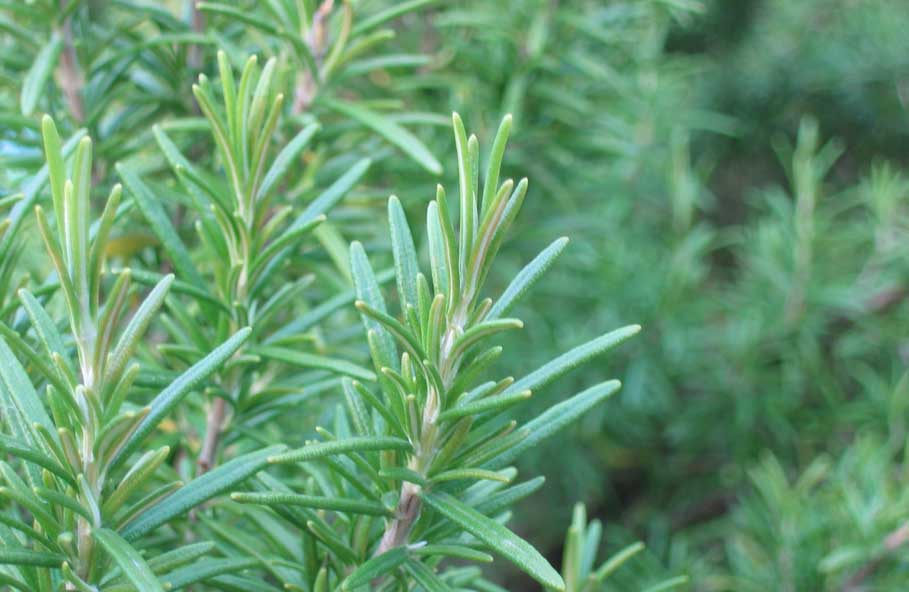Herbs: 9 Favorites and How To Grow Them
It’s easy to grow the most commonly used herbs. We have a small herb garden here at Behnke’s on the south-facing side of our building, and they do well with little care. All discussed below are perennials unless noted. The primary requirements are:
- Sun: the sun and heat of summer bring the flavors to the plant. It’s like home grown tomatoes vs store bought. Or outdoor herbs vs windowsill herbs.
- Drainage: many of our herbs are Mediterranean in origin, growing on dry, rocky hillsides. They don’t like wet feet. Our garden at Behnke’s is in a raised bed of potting soil and it works great.
 Genovese Basil
Genovese Basil
Basil: pick the kind you want—Italian, Greek, Thai…there are many different kinds with strikingly different flavors. Plant when it’s warm or hot, they rot off if planted in cool weather. Keep harvesting; pinch a couple of times a week to get fuller plants. They lose flavor as they go to flower, so keep removing the flowers as they form on older plants. Consider growing a couple of sets of plants six or eight weeks apart so that you have plenty of basil all season. When the second set is going strong, go ahead and pull out the first set of plants. Basil gets big. Three plants can provide plenty of leaves for batches of pesto. Basil is an annual, it will die in the fall.
Parsley: parsley is a biennial. Harvest the leaves the first year, and it should overwinter and give you more in the late winter before it bolts (goes to flower) and dies. You may get some caterpillars on the parsley; these are swallowtail butterflies. If you don’t have too many, let them feed. Parsley also makes a nice ornamental filler in mixed annual containers. Curly parsley is prettier, but flat Italian parsley has more flavor.
 Sage
Sage
Sage: a couple of plants of this perennial will provide plenty of leaves, and it’s evergreen(ish) in most winters. Available in golden or white variegated, purple, or classic gray. Nice blue flowers in late spring, too. Prune it back right after blooming (if you care about the flowers) or in early spring to keep it low and full; cut out dead branches as it leafs out in spring, once you are sure it’s dead. They get straggly if not cut back once a year or so. Hummingbirds often visit sage.
 Oregano
Oregano
Oregano: one plant will give you all you need, and if you don’t keep an eye on it, it will take over the garden. After the first year or two, you should pull it up at the edge of the clump to keep it contained, or grow it in a pot. Bees absolutely go nuts over the flowers; great pollinator plant. Low-growing, cut it back short right after flowering and in about three weeks it will have leafed out again.
 French Tarragon
French Tarragon
French Tarragon: pretty much a weed, one or two plants will make a nice clump in a couple of years. I cut them back hard in early to mid-summer and let them flush back out (leaf out) to improve the (generally lacking) ornamental aspect of the plant.
 Chives
Chives
Chives: little clumps of onions, the leaves are chopped and put on baked potatoes with sour cream, or in soup. I find them a little rank, myself so you don’t need much. The flowers are pretty little lavender balls, and they will self-seed over time. One or two pots to start should last you a lifetime once it gets established. Pest-free.
Mint: it can run, and you can’t hide. Grow it in a pot, and on a deck, not in or even setting on the ground. It will grow through the drainage holes into the soil. Very aggressive, especially in moist, loose soil. It is somewhat shade tolerant but you should have better flavor (oils) develop in full sun.
 Rosemary
Rosemary
Rosemary: more challenging but, soooo worth it. Drainage is critical, and look for the more winter hardy varieties like ‘Arp’ or “Hill Hardy”. Put this evergreen in an area protected from harsh, drying winter winds (e.g.; the south side), and mulch with gravel instead of bark. For more on rosemary, follow this link to the National Arboretum http://www.usna.usda.gov
Lavender: a genuine challenge here. In addition to the suggestions for rosemary, lavender is also disease- prone in our humid summer climate. Lavenders are like the guys with the red shirts in Star Trek; not all of them are going to make it. Good air circulation (hort talk for breezes) in summer will help, and don’t buy a plant showing any signs of dieback or wilting. When in bloom, you will have the happiest darn bumblebees in the world visiting your flowers all day long.
For a real treat, visit the Herb Garden at the US National Arboretum, in DC. It’s huge and amazing, plus you’ll be able to see plenty of different rosemary and lavender plants and decide for yourselves which ones you like. You can never miss with a trip to the Arboretum. (click here for their website).
by Larry Hurley, Behnke horticulturist

How best to grow indoors in an apartment?
Really easy to grow herbs indoors and in an apartment Just make sure they have good soil and that you can put them in a sunny window for at least part of the day. Thats all there is to it, honestly.
how do you grow them indoors?